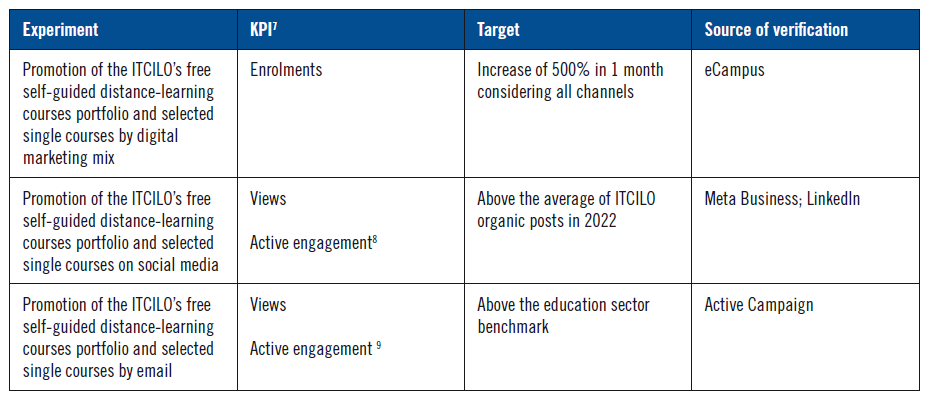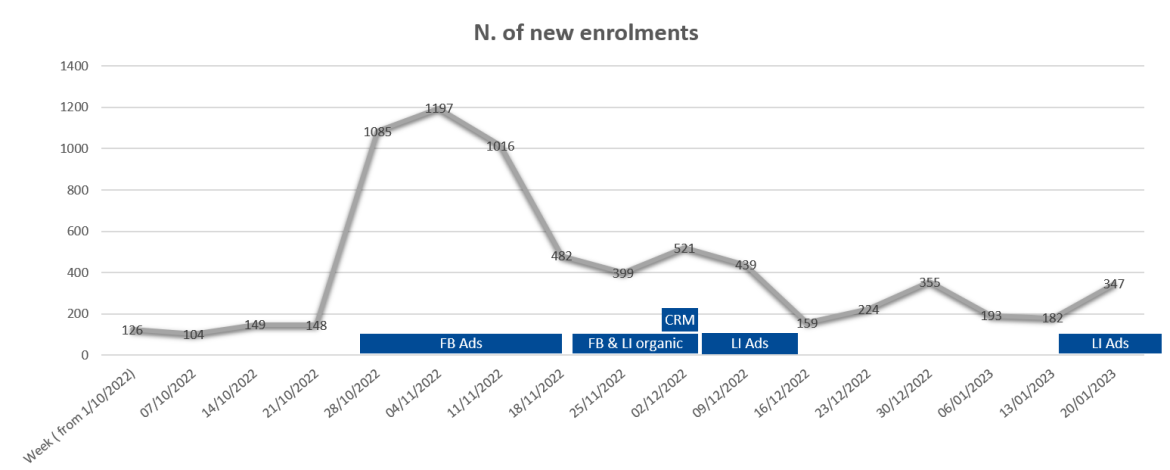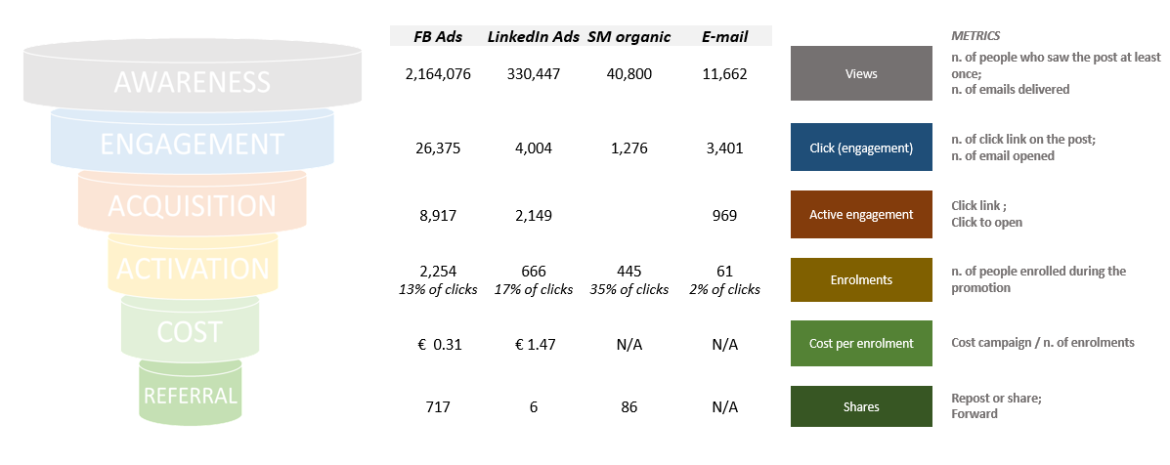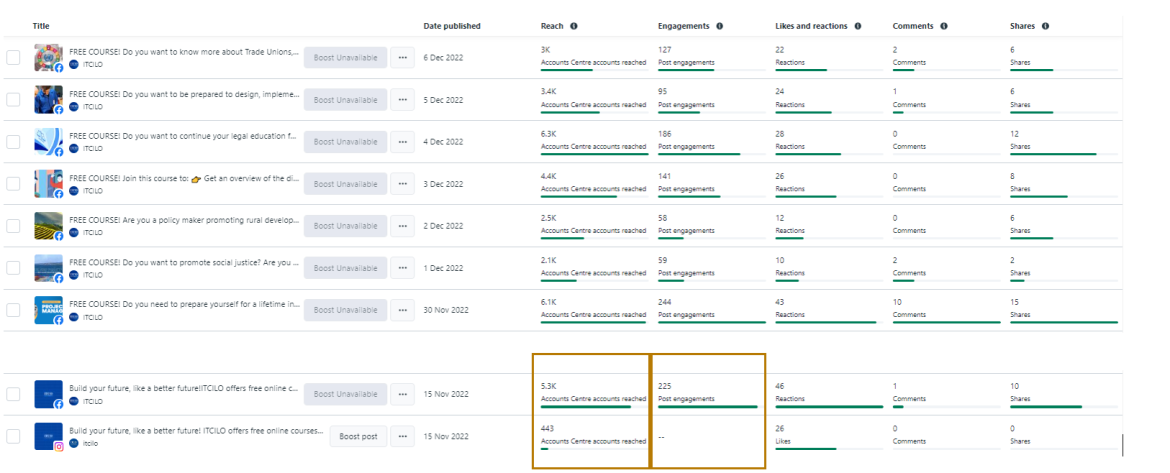Data-driven services to increase the centre’s training outreach by promoting free self-guided distance-learning courses
Paper brief
Data-driven services to increase the centre’s training outreach by promoting free self-guided distance-learning courses
Implementing recommendations and additional findings: experiment no. 2
Introduction
This experiment is part of a series of tests to boost uptake of the Centre’s training services performed in 2022, using data for evidence-based management. It built on earlier findings regarding the right digital-marketing mix required to increase training outreach and the role of free self-guided distance-learning courses in stimulating the uptake of fee-based services (see the previous experiment here).
Objectives of the experiment
- The overall objective of the experiment was to contribute to the achievement of the outcomes of the 2022–23 ITCILO Programme and Budget.
- The immediate objective of the experiment was to strengthen the capacity of the Technical Programmes of the Training Department to reach a larger number of people in the world of work with the right services through the right channel, here by experimenting with segment-specific promotional activities informed by marketing data analytics.
- The expected overall outcome of the experiment was an expanded participant universe.
- The expected immediate outcome was to provide the Centre’s Technical Programmes with a strengthened knowledge base on (a) how to develop and raise awareness of their free self-guided distance-learning courses (marketed as stand-alone offerings or in bundles) and (b) how best to convert leads into participants by using different marketing channels
Scope
The scope of the experiment was limited to the promotion of the Centre’s free self-guided distance-learning courses, in particular the following 7 courses
Key Performance Indicators
The Key Performance Indicators (KPI) for measuring the results of the experiment were


The experiment also used a data-driven marketing funnel to compare the results of the promotional activities on the different channels
5. The 2 tests: promoting single courses and the entire portfolio
Two tests have been conducted, focused on leveraging data analytics and digital marketing channels to enhance the Centre's training outreach and improve the effectiveness of their promotional activities.
In the first test seven flagship free self-guided distance-learning courses were selected or developed from the Centre's existing portfolio. These courses were promoted to specific target groups or personae based on their interests, education, keywords, job roles, and organizations. The promotion was carried out through various digital marketing channels, including social media channels such as Facebook, Instagram, LinkedIn, and email newsletters using a CRM application called Active Campaign. The test aimed to expand the participant universe and provide the Technical Programmes with a stronger knowledge base on how to develop and raise awareness of their free self-guided distance-learning courses.
The second test focused on promoting the entire portfolio of free self-guided distance-learning courses offered by the Centre. It aimed to increase participants' awareness of the courses and boost outreach. The experiment involved three digital marketing channels: social media (organic posts), email newsletters, and the eCampus platform. The promotion was carried out through a single social media post on the Centre's Facebook and Instagram pages, an email sent to subscribers of the Centre's newsletter, and by inserting a link to the portfolio of free courses on the eCampus pages of the selected flagship courses.
5.1 Test 1: Promotion of selected free Self-guided distance-learning courses to further investigate other channels for increasing training outreach and other possible segmentation variables
The results of the first part of the experiment show that targeted outreach campaigns specific to given distance-learning courses further drive up demand.
Look at the following graphics to see the trend of enrolments triggered by the digital marketing campaigns per week.

A closer look at the number of enrolments by course sheds further light on the effectiveness of digital marketing. As the next graphic suggests, there is a correlation but no causality: enrolments go up in all courses as a result of the campaign but the topic of each course still makes an important difference.
Learn from the next graphics the impact of different digital marketing tools at a higher level of resolution in each step of the marketing funnel.

The revised funnel shows people’s level of awareness (seeing the post or receiving the email), their engagement with the communications (minimum level of interest measured by their clicking on the post or opening the email), their acquisition (consideration of the learning opportunity measured by their clicking on the course link), their enrolment (new enrolments on the course eCampus page) and cost per enrolment (if paid campaign,) and finally their referrals (when the recipient become an “ambassador” for ITCILO free SG courses by sharing the post/email with their network).
The results show that the conversion rate of social media organic posts was very high (35%), followed by LinkedIn Ads (17%). In terms of absolute numbers, 2,254 new enrolments came from Facebook Ads and the cost of a new enrolment was very low (€0.31). In terms of awareness, Facebook Ads were very effective with more than 2 million people seeing the post at least once or receiving the emails.
As a result, we can state that it is important to coordinate and integrate different promotional channels. In this case, promoting first on Facebook Ads and then organically could have helped to expand the audience interested in free SG DL courses through paid promotion and then increase the engagement and conversion rate.
5.2 Test 2: Promotion of the ITCILO’s portfolio of free self-guided distance-learning courses
The results of the second part of the experiment show that centralized digital marketing boosts awareness and response rates, although effectiveness varies from channel to channel.
Look at the following graphic that compares the results of single course and the portfolio promotion: when the green bar is almost fully extended means that performance was far above average. This is the case for the promotion of four of the single courses, and of the portfolio promotion. Tracking and increasing views is important as, in general, a higher number of page views can lead to increased traffic to the ITCILO website.*
*Search engines like Google take into account various factors in determining the ranking of websites on their search engine results pages. If a website receives a high number of views and positive user interactions, it will help to increasing its authority and relevance in the eyes of a search engine and potentially improve its ranking.

The above graphic compares the results for the promotion of the portfolio of the free self-guided distance-learning courses (test 1) with those for each individual course (test 2). Considering the views/number of people reached (FB: 5.3K, IG: 443), engagement (FB: 225, IG: N/A), likes and reactions (FB: 46, IG: 26), comments (FB: 1, IG: 0) and shares (FB: 10, IG: 0), the Facebook post promoting the portfolio performed well in relation to the results for the individual free SG DL courses posted organically. However, ITCILO presence on Instagram could be improved.

Results differed from course to course. The differences in numbers of people reached and engagement in the posts promoting the individual courses (which were published within one week, one post at a time) confirm that the principal driver in stimulating demand continues to be the course topic.
6. Conclusions and Recommendations
6.1 Conclusions
The results of the tests lead us to conclude that:
- Meta, in particular Facebook Ads, is a very effective channel for the promotion of the free self-guided distance-learning courses as it stimulates enrolment in the promoted courses. However, there is scope for the ITCILO to improve its performance on LinkedIn and Instagram. In any case, while the choice of marketing channel influences results, the principal driver in stimulating demand continues to be the course topic. Aside from the channel mix, the geographical distribution of Facebook campaigns was not particularly efficient for certain areas, such as North and South America, Australia, north Europe, East Asia and North Africa. This may have been influenced by the language of the courses (mainly English), but it is important to reach countries and groups where we do not have a presence, so that we can spread the values of social justice and decent work around the world.
- Marketing mix: coordinating and integrating different promotional channels can help the ITCILO to reach more people and so increase views, engagement and enrolments. During this experiment, promoting first on Facebook Ads and then organically was helpful in expanding the audience interested in free self-guided distance learning courses through paid promotion. It was also helpful in increasing the engagement and conversion rates of our organic posts promoting the free self-guided distance-learning courses to our followers. Furthermore, an effective social media promotion that stimulates uptake increases the number of contacts on the ITCILO’s CRM systems as their email addresses are imported into the list of contacts for future promotional campaigns.
- Both centralized and course-specific campaigns are effective in increasing visibility, engagement and enrolments in ITCILO training activities. The centralized promotion of free self-guided distance-learning courses via social media stimulates course uptake. To further improve uptake, these global campaigns should be accompanied by course-specific campaigns, ideally targeting groups of potential participants (personae) known to be more inclined towards online learning.
6.2 Recommendations and future experiments
For the Office of the Director of Training
- Support Technical Programmes in developing additional free flagship self-guided distance-learning courses.
- At regular intervals, promote all free self-guided distance-learning courses and other types of courses to the beneficiary universe on Meta (Facebook in particular).
- Increase our presence and expertise on the current channels (for example Instagram, LinkedIn, YouTube, Twitter) with the help of LIP and ICTS.
- Further investigate engagement, conversion rates and beneficiaries’ needs across channels to increase training outreach.
- Coordinate and integrate the promotion of training activities on different channels. In particular, after a social media paid promotion, engage with followers through organic posts.
For Technical Programmes
- Develop at least one flagship free self-guided distance learning course per main area of expertise.
- Create a learning journey path on eCampus that can help participants to learn more about ITCILO training activities from the “Quick survey on the eCampus” conducted in September 2022.
- Use social media in general and Facebook Ads in particular to boost CRM and increase the universe of contacts.
- Use social media campaigns to significantly increase visibility and product awareness across the beneficiary universe.
Future experiments
ITCILO can investigate how to:
- Expand the digital marketing mix, testing new channels (in particular Google Ads) as a way of increasing training outreach among core constituents, targeting groups with known vulnerabilities and groups of people in the unreached market. Use predictive marketing analytics and artificial intelligence to identify which new courses to promote, to which audiences, through which channels, at what times and with what messages.
- Incentivize follow-up enrolments, for example by embedding links to follow-up training activities and by offering the prospect of gaining a higher-level learning credential, for instance a diploma.
- Target email and social media campaigns efficiently to follow up on potential leads, customizing the message to the recipients’ languages and known interest in topics.
- Conduct data analysis of the social media audience. It is important to understand ITCILO followers on social media so as to engage better with them and expand social media outreach with the main objective of sharing knowledge about social justice and decent work in the world of work.
Original paper by:







